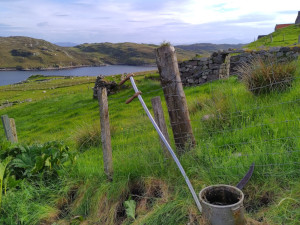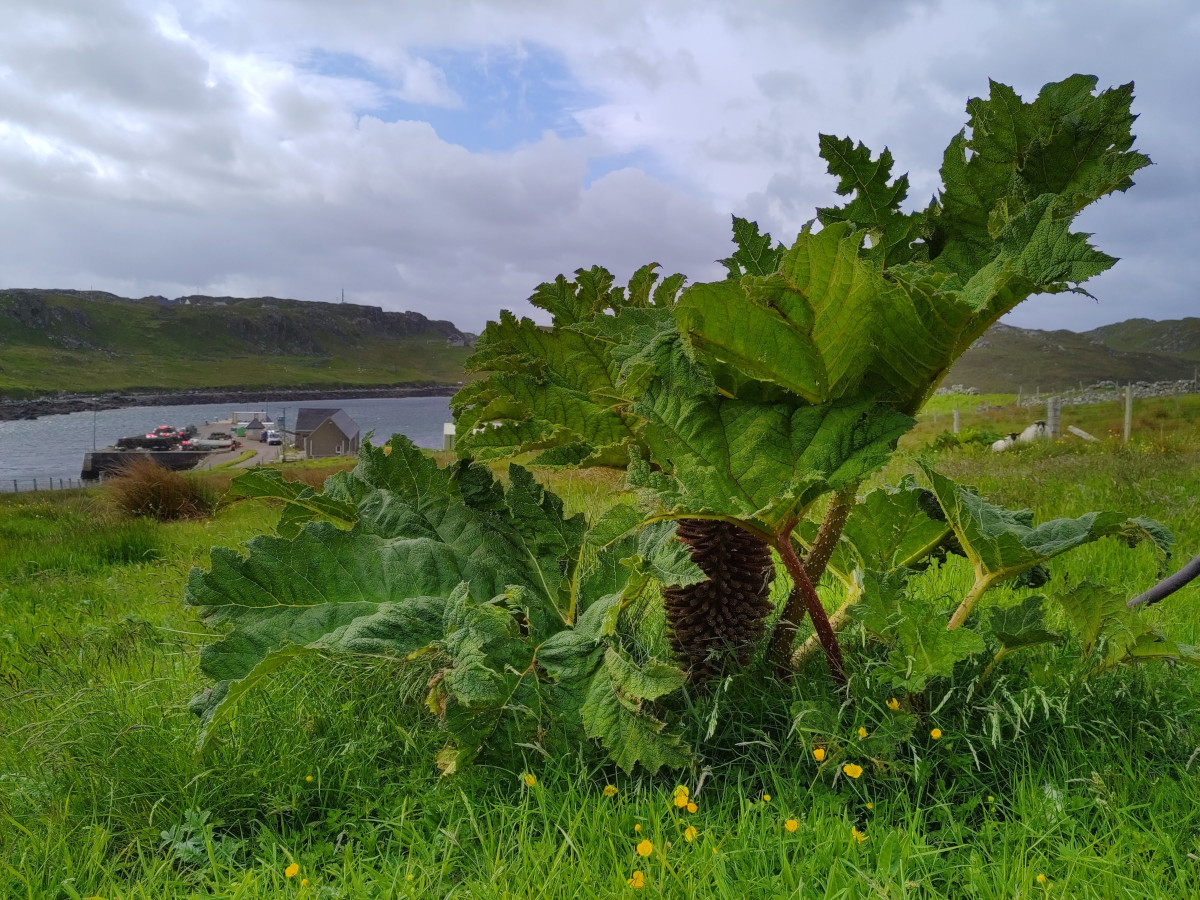When we bought the croft, we had only seen it in winter and being previously in Durness close to Cape Wrath, we had never heard of Gunnera tinctoria or the Giant Rhubarb. A lot of things are being said about it such as that it is poisonous which is not accurate since it is eaten in South America. The thing is that like many wild plants, they can contain some oxalic acid which can affect people with weak kidneys if you eat it in excess. Sure enough, it looks totally alien and scary as it is massive, resilient, spiky and red.
 The massive reproductive cone which is red and full of seeds (up to 250000) is kind of worrying too. The seeds are apparently to the taste of starlings in particular, a bird pretty common in the area. This, in combination with other factors have lead to it being able to spread like wildfire on the Isle of Lewis. At the difference from its Brazilian cousin Gunnera manticata, Gunnera tinctoria is ranked as invasive and is banned from selling since 2018 in the EU and the UK. There is a set of recommendations to control its spread and a large program has been established in the Hebrides to get rid of it. The strategy mostly rely on spreading chemicals on it at the end of summer. We have decided to do differently due to different observations we made on the croft.
The massive reproductive cone which is red and full of seeds (up to 250000) is kind of worrying too. The seeds are apparently to the taste of starlings in particular, a bird pretty common in the area. This, in combination with other factors have lead to it being able to spread like wildfire on the Isle of Lewis. At the difference from its Brazilian cousin Gunnera manticata, Gunnera tinctoria is ranked as invasive and is banned from selling since 2018 in the EU and the UK. There is a set of recommendations to control its spread and a large program has been established in the Hebrides to get rid of it. The strategy mostly rely on spreading chemicals on it at the end of summer. We have decided to do differently due to different observations we made on the croft.
Observations
 The cones are starting to appear in April-May. According to the literature, they should be mature from June in the UK. It seems then logical to get rid of at least the reproductive cones before they mature. That would considerably reduce the potential of the plant to reproduce with their seeds and thus conquier distant areas thanks to river or bird transportation. So I started cutting with a knife the pods I found. Very quickly this became tedious as they were hundreds of plants on the croft. To be faster, I started scything them.
The cones are starting to appear in April-May. According to the literature, they should be mature from June in the UK. It seems then logical to get rid of at least the reproductive cones before they mature. That would considerably reduce the potential of the plant to reproduce with their seeds and thus conquier distant areas thanks to river or bird transportation. So I started cutting with a knife the pods I found. Very quickly this became tedious as they were hundreds of plants on the croft. To be faster, I started scything them.
 I spent many days trying to find Gunnera and scythe it. Unfortunately this came at the cost of 2 blades. I am not sure I will make a post about scything but I buy the famous hand forged blades Falci. They are some of the best you can get. However, the vegetation is pretty dense, not only because of the Gunnera but also because the croft was not grazed for 3 years before we took over. I have now found a “black bear” Falci blade that is adapted to our water-logged summer meadow vegetation and doesn’t break. You can buy it in Wales, to these amazing people at Scythe Cymru.
I spent many days trying to find Gunnera and scythe it. Unfortunately this came at the cost of 2 blades. I am not sure I will make a post about scything but I buy the famous hand forged blades Falci. They are some of the best you can get. However, the vegetation is pretty dense, not only because of the Gunnera but also because the croft was not grazed for 3 years before we took over. I have now found a “black bear” Falci blade that is adapted to our water-logged summer meadow vegetation and doesn’t break. You can buy it in Wales, to these amazing people at Scythe Cymru.
 While cutting, I discovered patches that had very little grass, were quite water logged and contained the root ball of Gunnera plants. The places had been sprayed following the program of eradication. The last spray on our croft was summer 2019. It had evidently damaged the grazing but, to my surprise, almost no Gunnera died. The plant seemed unable to produce leaves were it had been sprayed but the root was perfectly alive. So from chopping them down I considered digging them up. Although I may have dug up several hundreds of them over the last year, I still find a plant that is still alive every now and then.
While cutting, I discovered patches that had very little grass, were quite water logged and contained the root ball of Gunnera plants. The places had been sprayed following the program of eradication. The last spray on our croft was summer 2019. It had evidently damaged the grazing but, to my surprise, almost no Gunnera died. The plant seemed unable to produce leaves were it had been sprayed but the root was perfectly alive. So from chopping them down I considered digging them up. Although I may have dug up several hundreds of them over the last year, I still find a plant that is still alive every now and then.
 All of the roots, until recently are alive when dug. I realised that these plants had some strange blue tainted patterns when sliced. This colouring is not natural in plants and I immediatly thought about mycological symbiosis of the type arbuscular mycorrhiza, where the mycelium penetrates the roots of the plants allowing the plants to pump a maximum of nutrients in exchange of sugar. I thought I had nailed it, the chemical burns the plant but it has fellow that allows it to survive with limited photosynthesis for years.
All of the roots, until recently are alive when dug. I realised that these plants had some strange blue tainted patterns when sliced. This colouring is not natural in plants and I immediatly thought about mycological symbiosis of the type arbuscular mycorrhiza, where the mycelium penetrates the roots of the plants allowing the plants to pump a maximum of nutrients in exchange of sugar. I thought I had nailed it, the chemical burns the plant but it has fellow that allows it to survive with limited photosynthesis for years.
Turns out I was wrong. Gunnera is not symbiotic with a mushroom but with a … cyanobacteria, a Nostoc bacteria (so-called blue algea). This has been well documented in this research paper or here in a simplified version. It turns out the genre Gunnera cannot get nitrogen by themselves and the Nostoc provides it to the plant in exchange of some food.
Recently, some roots have shown to die after having been sliced and dug up. Sounds not much of a progress but last year, they used to survive this kind of treatment. I believe this is because the croft is now much much better drained. Nostoc is really a bog-loving bacteria and you need a lot of water for it to thrive and in consequence to be able to help Gunnera t.. Considering the scale of the spreading of Gunnera, chemical spraying was probably what appeared to be the solution. Clearly the priority would be to not let it make viable seeds and thus get treated before June. That would create other problems in the middle of the agricultural production season. The permaculture approach we used will hopefully prevent the plant to spread from our croft but also forced us in making our soil better in the long run as Nostoc can be the vector of infections, in particular to dogs.

